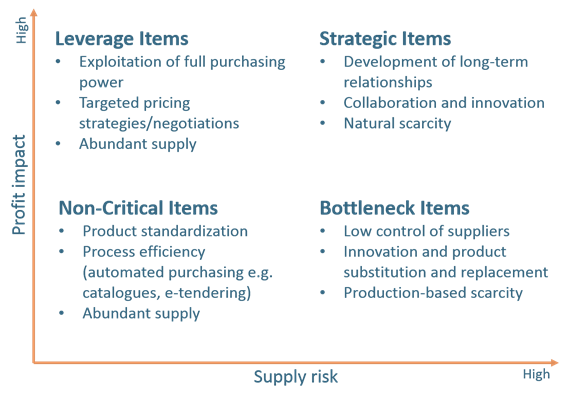Many organizations, particularly in the purchasing department, find it difficult to clearly see, manage and optimize spend across the organization due to decentralized procurement processes, disparate systems and fragmented data.
But there’s good news. The growing trend of building integrated business intelligence solutions has opened the door for dramatic transformation and optimization around both direct and in-direct procurement — making it easier and quicker to see what and how your organization is spending. This offers a unique opportunity for your enterprise to unlock substantial value and optimize your existing strategic procurement organizations. The result: a purchasing department able to be proactive in building strategic sourcing models and managing key performance metrics that holistically address enterprise spend.
What Does “Spend Analytics” Mean for Your Company?
Spend analytics can help provide deep insights across the entire source-to-pay process. From developing category intelligence, to driving lower vendor pricing, to establishing and monitoring compliance to better manage spend demand, analytics can become a critical enabler.
Strategic category management involves leveraging historical information, infusing external information, and implementing predictive algorithms that enable you to become more strategic in those categories. For example, by using category and supplier analytics, intelligent augmentation can help you improve price points based on market knowledge, identify best-in-class suppliers, create negotiation strategies specific to suppliers, and identify and avoid risk through more effective supplier qualification.
Enhancing spend governance and compliance through analytics allows greater visibility into whether preferred suppliers are being used to take advantage of negotiated prices and discounts. Similarly, managing buying channel compliance helps to ensure purchases are being made through the right channels and contracts to minimize operating costs. Other key compliance areas include purchase order policy compliance, usage of P-Cards, travel and entertainment, and so on.
Whereas a single focus on purchase price, using category management routes such as aggregation and negotiation, can contribute to 10% to 20% in value realization (price reduction), a more strategic approach of both supplier and demand management can see three to five times greater value realization.
How You Can Use Procurement KPIs and the Kraljic Matrix
The availability of real-time, integrated data has opened the doors wide open to allow purchasing departments to become much more proactive and strategic. One such strategy, defined by supply chain thought leader Peter Kraljic, segments purchases depending on the item’s supply risk (market, performance and complexity risk) and the item’s profit impact (impact on operating cost and profitability, importance of purchase and value of purchase).
Using supply risk and profit impact as the two primary measuring sticks, purchasing spend is categorized into four main buckets with sets of knowledge performance indicators (KPIs) to manage, monitor and drive specific performance. Leverage items and non-critical items, such as office supplies, should focus on hard savings, for example; while strategic items should focus on supplier innovation and mitigating risk.
Below are six strategic objectives, measurable through KPIs that can be applied to each quadrant, depending on the supply risk and the profit impact:
- Hard savings — direct impact to the bottom line.
- Soft savings — potential benefits to the bottom line, but harder to quantify. Examples of soft savings include reduced time to market, improved employee morale and other intangibles.
- Ensuring compliance — includes supplier on-time delivery rate and supplier defect rate.
- Supplier innovation — supplier-driven ideas for cost savings, cost avoidance and revenue growth. Innovative procurement organizations solicit ideas from suppliers and measure the contribution of these ideas.
- Reduction in maverick buying — unplanned or uncontrolled procurement. For manufacturing companies, maverick buying comprises of the majority of maintenance, repair and overhaul (MRO) costs and can account for 30% to 45% of all indirect purchase value.
- Risk mitigation — risks include cost volatility, supply disruption, non-compliance fines, as well as situations that may damage the organization’s brand and reputation.

Source: Peter Kraljic, HBR
Using an executive-level dashboard, procurement leaders can see the performance of each quadrant at a glance. In addition to tracking quadrant performance, such a dashboard allows the procurement leader to identify common themes across quadrants. Leverage and non-critical quadrants, for example, are both low supply risk and often driven by cost savings; sluggish performance in both quadrants could indicate the need for better purchasing processes or pricing negotiations.
The procurement process yields vast amounts of valuable data that can be used to mine trends, manage demand and realize value. That data can reside both internally and externally, but for most enterprises remains elusive to harness and convert into actionable insights. Building and enhancing data analytics capabilities are key building blocks to unlock this value. Regardless of where your company lies in the data analytics and procurement function maturity scale, aiming to get to that “next level” can make a world of difference.
Contact John Cavalier at jcavalier@cohenco.com or a member of your service team for further discussion.
Cohen & Co is not rendering legal, accounting or other professional advice. Information contained in this post is considered accurate as of the date of publishing. Any action taken based on information in this blog should be taken only after a detailed review of the specific facts, circumstances and current law.